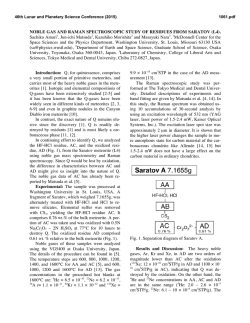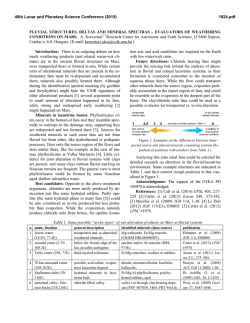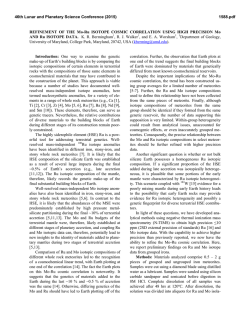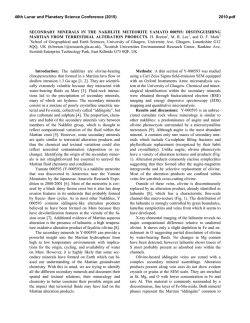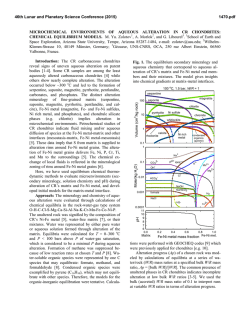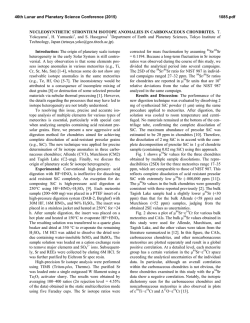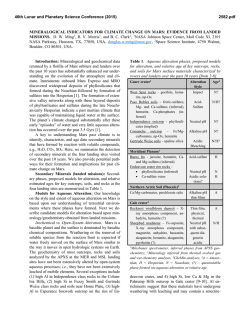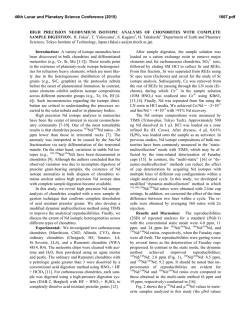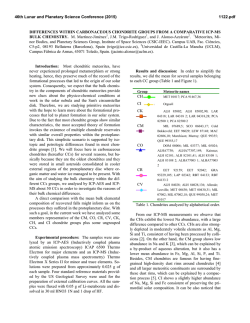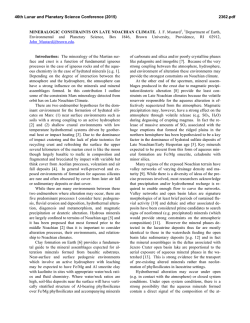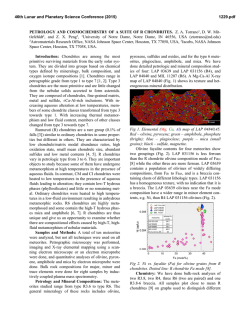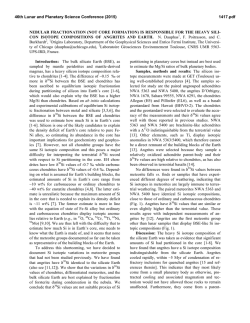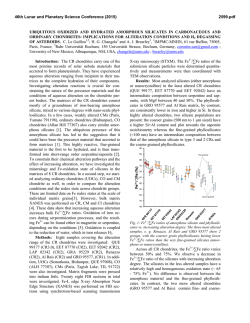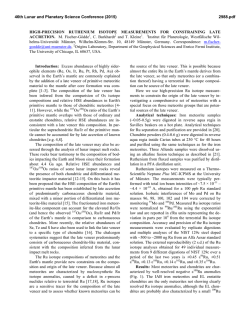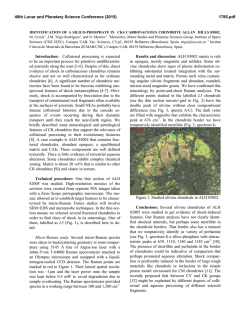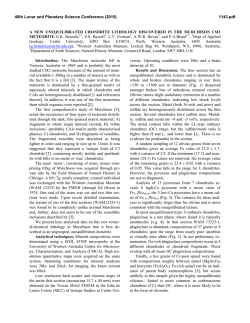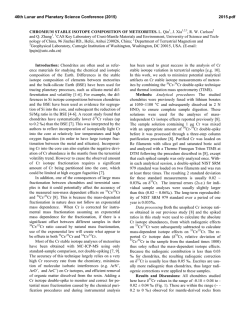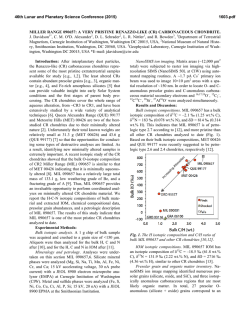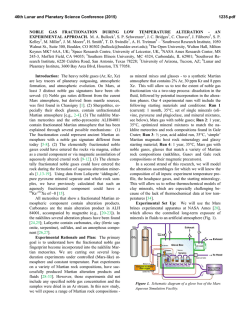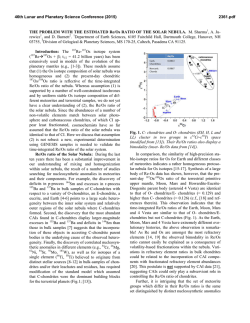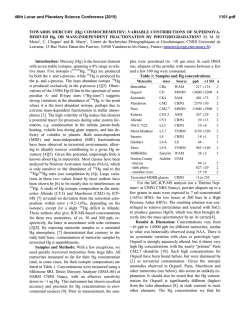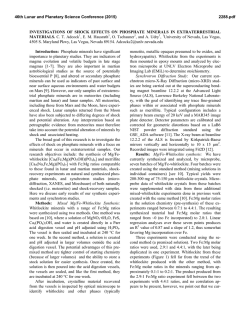
ultra high resolution transmission electron microscopy of matrix
46th Lunar and Planetary Science Conference (2015) 1198.pdf ULTRA HIGH RESOLUTION TRANSMISSION ELECTRON MICROSCOPY OF MATRIX MINERAL GRAINS IN CM CHONDRITES: PREACCRETIONARY OR PARENT BODY AQUEOUS PROCESSING? J.M. Trigo-Rodríguez1, J. Alonso-Azcárate2, M. M. Abad3, and M. R. Lee4, 1Meteorites, Minor Bodies, and Planetary Sciences Group, Institute of Space Sciences (CSIC-IEEC). Campus UAB, Fac. Ciències, C5-p2, 08193 Bellaterra (Barcelona), Spain ([email protected]). 2Universidad de Castilla-La Mancha (UCLM), Campus Fábrica de Armas, 45071 Toledo, Spain. 3Centro de Instrumentación Científica (CIC), Universidad de Granada, 18071 Granada, Spain. 4 School of Geographical and Earth Sciences, University of Glasgow, Glasgow G12 8QQ, UK. Introduction: CM chondrites are highly hydrated meteorites associated with a parent asteroid that has experienced significant aqueous processing. The meteoritic evidence indicates that these non-differentiated asteroids are formed by fine-grained minerals embedded in a nanometric matrix that preserves chemical clues of the forming environment. So far there are two hypothesis to explain the presence of hydrated minerals in the content of CM chondrites: one is based on textural features in chondrule-rim boundaries [1-3], and the other ‘preaccretionary’ hypothesis proposes the incorporation of hydrated phases from the protoplanetary disk [4-6]. The highly porous structure of these chondrites is inherited from the diverse materials present in the protoplanetary disk environment. These bodies were presumably formed by low relative velocity encounters that led to the accretion of silicate-rich chondrules, refractory Ca- and Al-rich inclusions (CAIs), metal grains, and the fine-grained materials forming the matrix. Owing to the presence of significant terrestrial water in meteorite finds [7], here we have focused on two CM chondrite falls with minimal terrestrial processing: Murchison and Cold Bokkeveld. Anhydrous carbonaceous chondrite matrices are usually represented by highly chemically unequilibrated samples that contain distinguishable stellar grains. Other chondrites have experienced hydration and chemical homogeneization that reveal parent body processes. We have studied CM chondrites because these meteorites have experienced variable hydration levels [8-10]. It is important to study the textural effects of aqueous alteration in the main minerals to decipher which steps and environments promote bulk chemistry changes, and create the distinctive alteration products. It is thought that aqueous alteration has particularly played a key role in modifying primordial bulk chemistry, and homogenizing the isotopic content of fine-grained matrix materials [7, 11, 12]. Fortunately, the mineralogy produced by parent-body and terrestrial aqueous alteration processes is distinctive [5, 11]. Experimental procedure: First of all, the meteorite sections were thinned in a ring as usually made for TEM studies using a Fischione 1050 ion mill at CIC (Granada University). The sample was bombarded with energetic ions or neutral atoms (Ar), removing sample material until the film was sufficiently thin to study by TEM. The result is a thinned ring that is cleaned to remove away the remaining amorphous materials and then analyzed by UHRTEM (ultra high resolution transmission electron microscopy). The study was performed using a FEI Titan G2 60-300 microscope available at CIC with a high brightness electron gun (X-FEG) operated at 300 kV and equipped with a Cs image corrector (CEOS) and for analytical electron microscopy (AEM) a SUPER-X silicon-drift windowless EDX detector. The AEM spectra were collected in STEM (Scaning Transmission Electron Microscopy) mode using a HAADF (High Angle Annular Dark Field) detector. Digital X-Ray maps were also collected on selected areas of the samples. For quantitative micro-analyses, EDX data were corrected by the thinfilm method [12-13]. The K-factors were determined using mineral standards. These samples were prepared as a Canada balsam-mounted thin sections, were thinned using a Fischione 1050 model ion mill, and carbon coated for TEM observation with the Titan microscope. Atomic concentration ratios were converted into formulae according to stoichiometry (number of O atoms in theoretical formulae). Results and discusion: As found in previous studies [2], Murchison matrix is composed of very heterogeneous materials even at the nanoscale. From the different imagery obtained we have selected some examples to illustrate the level of complexity found. Figure 1 shows a 1 µm window of the Murchison matrix where the center includes a phase with the characteristic layering of phylosilicates oriented perpendicularly to the line of sight. This figure includes small numbered boxes where several EDX spectra were taken. Serpentine in its variety of lizardite is representative of boxes #1 and 4, but in #2 and 3 we found a mixture of serpentine with cronstedtite. Other minerals tentatively identified from their EDX spectra are: #5,6 pentlandite, #8 carbonate or sulphate, #11 pyrrhotite, and #12 pyroxene. In general the presence of these minerals exemplify an extraordinary diversity in CM2 chondrite Murchison. We think this complexity at nanoscale might be indicative of the formation conditions of this meteorite, and the little thermal processing occurred in its parent asteroid. 46th Lunar and Planetary Science Conference (2015) Figure 1. HAADF image showing a serpentinecronstedtite intergrowth phase surrounded by other minerals discussed in the text. Figure 2. Diffraction pattern of lizardite found in box #4 (see Fig. 1). Preliminary conclusions: A comprehensive study of the mineral phases of CM chondrites at nanoscale can provide important new information regarding their textural relationships and origins. We wish to answer key questions, for example was organic complexity associated with catalytic processes promoted by aqueous alteration of some specific minerals? We have found that Murchison matrix is exceptionally complex at the nanoscale. The existence of heavily aqueously altered minerals in close contact with anhy- 1198.pdf drous ones is remarkable. This could support by itself the idea of a wet accretion of some components of CM chondrites. Was this diversity a consequence of several stages in the accretion of chondritic parent bodies? [5]. On the other hand, Cold Bokkeveld has been more extensively aqueously alterered, as revealed by extended phyllosilicates all over our sample. In any case, as Cold Bokkeveld is a breccia it is difficult to reach general conclusions. Some minerals, like e.g. sulphates were formed in the parent bodies [14]. Future analytical work will enable us to be more precise about the conditions in which such extensive alteration took place. We previously concluded that aqueous alteration differences among CMs were the result of contrasts in the degree of collisional or burial compaction in the parent body [7,8]. This was also pointed out from the preferred orientation of the dominant serpentine phase [15]. This alteration has important implications in other areas like e.g. the reflectance diversity found in D-type asteroids. The growth of minerals of aqueous alteration in the pores of these carbonaceous chondrites [7] could have had a deep effect in decreasing the reflectivity of their hydrated parent bodies [16]. Acknowledgements: Finantial support from the Spanish MEC (research project AYA2011-26522). References: [1] Bunch T.E. and Chang S. (1980) Geochim. Cosmochim. Acta 44, 1543. [2] Zolensky M. and McSween H.Y. (1988) In Meteorites and the Early Solar System, Univ. Arizona press, Tucson, p. 114. [3] Browning et al. (1996) Geochim. Cosmochim. Acta 60, 2621. [4] Metzler K. et al. (1992) Geochim. Cosmochim. Acta 56, 2873. [5] Bischoff A. (1998) Meteorit. Planet. Sci. 33, 1113. [6] Hanowski N.P. and Brearley A.J. (2000) Meteorit. Planet. Sci. 35, 1291. [7] TrigoRodríguez J.M. et al. (2006) Geochim. Cosmochim. Acta 70, 1271. [8] Rubin A.E. et al. (2007) Geochim. Cosmochim. Acta 71, 2361. [9] Bland P. et al. (2006) in Meteorites and the Early Solar System II, D.S. Lauretta & H.Y. McSween Jr. (eds.), Univ. Arizona Press, Tucson, 853. [10] Zolensky M.E. et al. (1993) Geochim. Cosmochim. Acta 57, 3123. [11] Brearley A. and Jones R.H. (1998) In Planetary Materials, ed. Papike J.J., Washington, D.C.: Min. Soc. of America, 1-398. [12] Cliff G. and Lorimer G.W. (1975) J. Microscopy 103, 207. [13] Lorimer G.W. and Cliff G. (1976) In Electron Microscopy in Mineralogy, Springer-Verlag, Berlin, 506. [14] Lee M.R. (1993) Meteoritics 28, 53. [15] Fujimura A. et al. (1983) Earth Planet. Sci. Lett. 66, 25. [16] Trigo-Rodríguez J.M. et al. (2013) MNRAS, 437, 227-240. [17] Brearley A.J. (2006) in Meteorites and the Early Solar System II, D.S. Lauretta & H.Y. McSween Jr. (eds.), Univ. Arizona Press, Tucson, 587-624.
© Copyright 2026
